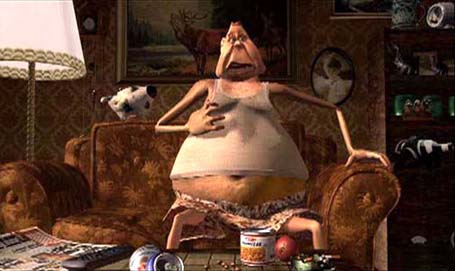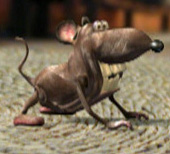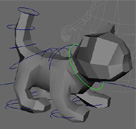
|

|
Manfred is the story of a couch-bound white trash German who has to decide between his two most prized possessions - his dog or his beer.
In order to create a documentary day-in-the-life look to epitomize Manfred's lethargy and pointlessness, the story is told from only one camera perspective - that of Manfred's constant companion - his television.
The absence of camera cuts presented a special challenge to maintain the personality of the characters as well as the attention of a MTV-acclimated audience for 1.5 minutes of uncut character animation. In this setting the theatrical concepts of staging, readable poses, and anticipation became paramount.
Realistic human skin remains one of the most difficult hurdles in the CG realm. Its difficulty lies in its complexity. Skin, with all its blemishes,
BEHIND THE SCENES
Human Skin Texture and Lightingflushes, translucency, pores, and hair, is never a single plastic color, but a combination of hundreds, if not thousands. Also since we are so familiar with the human complexion, a simple random repeating mix of color won't do. We expect the cheeks and the nose to be a bit more red, we know that the skin is darker around the eyes, and so on.

Screen Shot
Because of this, a detailed map (including acne, freckles and beard stubble), was prepared for Manfred and mapped onto the texture vertices of the model.
The next complication was in the lighting. If you look closely, skin has a very intricate and complex pattern to it which effects how it is illuminated by light. Even from far away, where the pattern is no longer visible, its effect on the specular highlights can still be seen. To simulate this phenomenon, a special shader node was developed that used a contrast node keyed to a skin pattern bump map (the black and white map on the left) for the specular lighting along with the aforementioned map for the color.
Color Map
Color Map (detail)
Specular Map
In other words, since human skin reflects light differently then a plastic ball or cloth would, just using a color map won't cut it.
For the textures in Manfred, IPR (Interactive Photorealistic Rendering) was used. IPR allows you to edit the texture interactively on a rendered image rather that on a shader-ball (like every other software does). I hope they can finally incorporate this revolutionary paradigm into Maya 2.0, cause I miss it there now.





MAIN COMMERCIALS SHORTS STUDIO MAKING OF CONTACT
(c) 2005, All Rights Reserved. "Make Links not Copies"